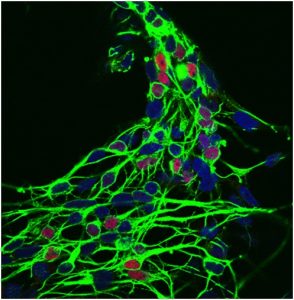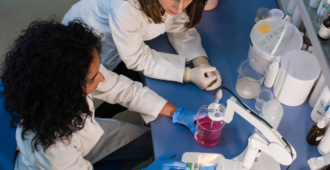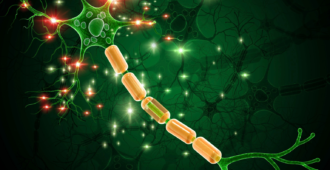Dr Jakub Scaber is a Medical Research Council (MRC)/ MND Association Lady Edith Wolfson Clinical Research Fellow who works in Professor Kevin Talbot’s Laboratory at the Oxford University. Like Prof Chandran’s research, Dr Scaber’s fellowship is also investigating stem-cell derived motor neurones, here he blogs about his research.
This is an image of motor neurons.
But not just any motor neurons – these are motor neurons that have been derived from skin cells of one of our patients who was a carrier of the most common mutation in the rare inherited form of MND (5-10% of total MND cases) – a mutation in the gene C9orf72.
Together with the help of Dr Sally Cowley and her team at the Oxford Martin Stem Cell Facility we have grown a tiny skin biopsy in a dish and then used genetic reprogramming techniques to make the skin cells believe that they are embryos again – and they actually do! Then we fed them certain foods and factors, because of this cocktail the cells believe that they are embryonic cells in the spinal cord and on their way to becoming motor neurons.
And most of them actually do become motor neurons! As the skin cells came from people that developed MND, this makes them so interesting to study. Previously we had not been able to study human motor neurons unless taken from human embryos (with the main source of previous motor neuron cultures being mouse embryos).
Prior to taking this picture on the microscope the cells had been labelled using special antibodies and chemicals. The blue dye is a chemical called DAPI which labels the DNA in the nucleus of the cell. It provides help with orientation. A green antibody was used to label a marker of nerve cells in general (enabling me to identify only the nerve cells). Red markers were then used to label proteins that are only found in motor neurons, allowing me to specifically identify and study these cells. The images were taken using a fluorescent microscope, which is specialised to pick up very precise signals from each of the three molecules.
Next steps? Well, I will be working on these motor neurons to study their properties in the next year and I hope to be able to report some more then!







are you using these stem cells on humans as yet please let me know also where you are as Im an Australian
Dear Paul,
Our researchers in the UK are only using these stem cells to study motor neurones in the lab, and not as a treatment for MND. You can find out more in our information sheet here: http://www.mndassociation.org/Resources/MNDA/Migrated%20Resources/Documents/S/F-%20stem%20cells%20-%20March14.pdf
Kind regards,
Samantha Price, PhD
Research Information Co-ordinator, MND Association, UK
Thank you Samantha, living with MND is difficult so I am looking at every thing that comes along. Thanks for your reply as not everyone gives a reply thanks again for your time